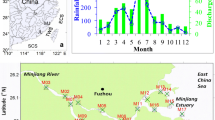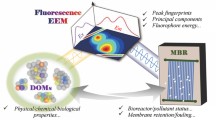Abstract
Fluorescence 3D excitation emission matrix (EEM) spectra of oil products in artificial seawater were monitored as a function of irradiation time in a solar simulator. EEMs were obtained for an excitation range of 240–400 nm and an emission range of 248–830 nm; this is the wavelength range typically used in chromophoric dissolved organic matter (CDOM) EEM studies in natural waters. This allows for comparison to prior work on CDOM in an oil-contaminated salt marsh that attributed a fluorescent component in the tryptophan/tyrosine protein-region to oil. For comparison, EEMs were also measured for a broader excitation range of 220–400 nm typically used in oil related studies to capture the primary oil peak at lower excitation wavelengths. Fluorescence intensities in both excitation wavelength ranges decayed exponentially with irradiation time consistent with first-order kinetics. There was little change in wavelength for primary oil peaks. However, in the CDOM, wavelength range peaks typically shifted to longer excitation and shorter emission wavelengths, moving into the protein peak region of the CDOM EEM spectrum. This is consistent with a decrease in the complexity of the structure of the organic material. Half-lives for photodegradation ranged from 0.36 to 7.2 days for the oil wavelength range and 0.14 to 28 days for the CDOM wavelength range. Higher density oils typically had higher degradation rate constants. Peak locations and peak behaviour are consistent with the primary fluorophore in the oil products being PAH-related.






Similar content being viewed by others

References
Beltran JL, Ferrer R, Guiteras J (1998) Multivariate calibration of polycyclic aromatic hydrocarbon mixtures from excitation-emission matrix spectroscopy. Anal Chim Acta 373:311–319
Bowen JC, Clark CD, Keller JK, De Bruyn WJ (2017) Optical properties of chromophoric dissolved organic matter (CDOM) in surface and pore waters adjacent to an oil well in a southern California salt marsh. Mar Pollut Bull 114:157–168
Bugden JBC, Yeugn CW, Kepkay PE, Lee E (2008) Application of ultraviolet fluorometry and excitation-emission matrix spectroscopy (EEMS) to fingerprint oil and chemically dispersed oil in seawater. Mar Poll Bull 56:677–685
Cao X, Tarr M (2017) Aldehyde and ketone photoproducts from solar-irradiated crude oil-seawater systems determined by electrospray ionization-tandem mass spectrometry. Environ Sci Technol 51:1355–1366
Christensen JH, Hansen AB, Mortensen J, Andersen O (2005) Characterization and matching of oil samples using fluorescence spectroscopy and parallel factor analysis. Anal Chem 77:2210–2217
Clark CD, Litz LP, Grant SB (2008) Saltmarshes as a source of chromophoric dissolved organic matter to Southern California coastal waters. Limnol Oceanogr 53:1923–1933
Clark CD, Aiona P, Keller J, De Bruyn WJ (2014) Optical characteristation of chromophoric dissolved organic matter (CDOM) in sediment porewaters from a Southern Californian salt marsh. Mar Ecol Prog Ser 516:71–83
Coble PG (1996) Characterization of marine and terrestrial DOM in seawater using excitation emission matrix spectroscopy. Mar Chem 51:325–346
De Bruyn W, Clark CD, Ottelle K, Aiona P (2012) Photochemical degradation of phenanthrene as a function of natural water variables modeling freshwater to marine environments. Mar Poll Bull 64:532–538
Fellman JB, Hood E, Spencer RGM (2010) Fluorescence spectroscopy opens new windows into dissolved organic matter dynamics in freshwater ecosystems: a review. Limnol Oceanogr 55(6):2452–2462
Ferretto N, Tedetti M, Guigue C, Mounier S, Redon R, Goutx M (2014) Identification and quantification of known polycyclic aromatic hydrocarbons and pesticides in complex mixtures using fluorescence excitation-emission matrices and parallel factor analysis. Chemosphere 107:344–353
Griffiths M, Da Campo R, O’Connor P, Barrow M (2014) Throwing light on petroleum: simulated exposure of crude oil to sunlight and characterization using atmospheric pressure photoionization Fourier transform ion cyclotron mass spectrometry. Anal Chem 96:527–534
Helms JR, Stubbins A, Perdue EM, Green NW, Chen H, Mopper K (2013) Photochmeical bleaching of oceanic dissoleved organic matter and its effect on absorption spectral slope and fluorescence. Mar Chem 155:81–91
Islam A, Cho Y, Yim UH, Shim WJ, Kim YH, Kim S (2013) The comparison of naturally weathered oil and artificially photo-degraded oil at the molecular level by a combination of SARA fractionation and FT-ICR MS. J Hazard Mater 263:404–411
Jiji RD, Andersson GG, Booksh KS (2000) Application of PARAFAC for calibration with excitation-emission matrix fluorescence spectra of three classes of environmental pollutants. J Chemometrics 14:171–185
Keizer PD, Gordon DC (1973) Detection of trace amounts of oil in seawater by fluorescence spectroscopy. J Fish Res Board Can 30:1039–1046
King SM, Leaf PA, Olson AC, Ray PZ, Tarr MA (2014) Photolytic and photocatalytic degradation of surface oil from the Deepwater Horizon oil spill. Chemosphere 91:415–422
Kothawala DN, Murphy KR, Stedmon CA, Weyhenmeyer GA, Tranvik LJ (2013) Inner filter correction of dissolved organic matter fluorescence. Limnol Oceanogr Methods 11:616–630
Lapworth DJ, Gooddy DC, Butcher AS, Morris BL (2008) Tracing groundwater flow and sources of organic carbon in sandstone aquifers using fluorescence properties of dissolved organic matter (DOM). Appl Geochem 23:3384–3390
Lawaetz AJ, Stedmon CA (2009) Fluorescence intensity calibration using the Raman scatter peak of water. Appl Spectrosc 63:936–940
Lemkau K, McKennell A, Podgorski D, Rodgers R, Reddy C (2014) Molecular evidence of heavy-oil weathering following the M/V Cosco Busan spill: insights from Fourier transform ion cyclotron resonance mass spectrometry. Environ Sci Technol 48:2780–2787
Miller W, Moran MA, Sheldon WM, Zepp RG, Opsahl S (2002) Determination of apparent quantum yield spectra for the formation of biologically labile photoproducts. Limnol Oceanogr 47:343–352
Moran MA, Zepp RG (1997) Role of photoreactions in the formation of biologically labile compounds from dissolved organic matter. Limnol Oceanogr 42(6):1307–1316
Murphy KR, Stedmon CA, Waite TD, Ruiz GM (2008) Distinguishing between terrestrial and autochthonous organic matter sources in marine environments using fluorescence spectroscopy. Mar Chem 108:40–58
Sgroi M, Roccaro P, Korshin V, Greco V, Scuito S, Anumol T, Snyder SA, Vagliasindi V (2017) Use of fluorescence EEM to monitor the removal of emerging contaminants in full scale wastewater treatment plants. J Haz Mat 323:367–376
Slasor L (2012) Slick spectra: a spectral fluorescence study of the water-accommodated fraction of crude oil. Thesis. https://digitalcommons.ohsu.edu
Stedmon CA, Markager S (2005) Resolving the variability in dissolved organic matter fluorescence in a temperate estuary and its catchment using PARAFAC analysis. Limnol Oceanogr 50(2):686–697
Stedmon CA, Markager S, Bro S (2003) Tracing disolved organic matter in aquatic environments using a new approach to fluorescence spectroscopy. Mar Chem 82:219–254
Stubbins A, Lapierre J-F, Berggren M, Prairie YT, Dittmar T, del Giorgio PA (2014) What’s in an EEM? molecular signatures associated with dissolved organic fluorescence in Boreal Canada. Environ Sci Technol 48(18):10598–10606
Tedetti M, Guige C, Goutx M (2010) Utilization of a submersible UV fluorometer for monitoring anthropogenic inputs in the Mediterranean coastal waters. Mar Poll Bull 60:350–362
Tzortziou M, Osburn CL, Neale PJ (2007) Photobleaching of dissolved organic material from a tidal marsh-estuarine system of the Chesapeake Bay. Photochem Photobiol 83:782–792. https://doi.org/10.1562/2006-09-28-RA-1048
Tzortziou M, Neale PJ, Megonigal JP, Pow CL, Butterworth M (2011) Spatial gradients in dissolved organic carbon due to tidal marsh outwelling into a Chesapeake Bay estuary. Mar Ecol Prog Ser 426:41–56. https://doi.org/10.3354/meps09017
Yamashita Y, Jaffe R, Maie N, Tanoue E (2008) Assessing the dynamics of dissolved organic matter (DOM) in coastal environments by excitation emission matrix fluorescence and parallel factor analysis (EEM-PARAFAC). Limnol Oceanogr 53:1900–1908. https://doi.org/10.4319/lo.2008.53.5.1900
Zhou Z, Guo L (2012) Evolution of the optical properties of seawater influenced by the Deepwater Horizon oil spill in the Gulf of Mexico. Environ Res Lett 7:025301
Zhou Z, Guo L, Shiller AM, Lohrenz SE, Asper VL, Osburn CL (2013a) Characterization of oil components from the Deepwater Horizon oil spill in the Gulf of Mexico using fluorescence EEM and PARAFAC techniques. Mar Chem 148:10–21
Zhou Z, Liu Z, Guo L (2013b) Chemical evolution of Macondo crude oil during laboratory degradation as characterized by fluorescence EEMs and hydrocarbon composition. Mar Chem 66:164–175
Zhou Z, Guo L, Osburn CL (2015) Fluorescence EEMs and PARAFAC techniques in the analysis of petroleum components in the water column. In: McGenity TJ et al (eds) Hydrocarbon and lipid microbiology protocols. Springer protocols handbooks. Springer-Verlag, Berlin, Heidelberg. https://doi.org/10.1007/8623_2015_137
Funding
The authors thank the National Science Foundation (CHE #1337396) for funding this work.
Author information
Authors and Affiliations
Corresponding author
Additional information
Responsible editor: Philippe Garrigues
Rights and permissions
About this article
Cite this article
de Bruyn, W., Chang, D., Bui, T. et al. Photochemical degradation of oil products in seawater monitored by 3D excitation emission matrix (EEM) fluorescence spectroscopy: implications for coloured dissolved organic matter (CDOM) studies. Environ Sci Pollut Res 25, 34777–34787 (2018). https://doi.org/10.1007/s11356-018-3190-9
Received:
Accepted:
Published:
Issue Date:
DOI: https://doi.org/10.1007/s11356-018-3190-9



